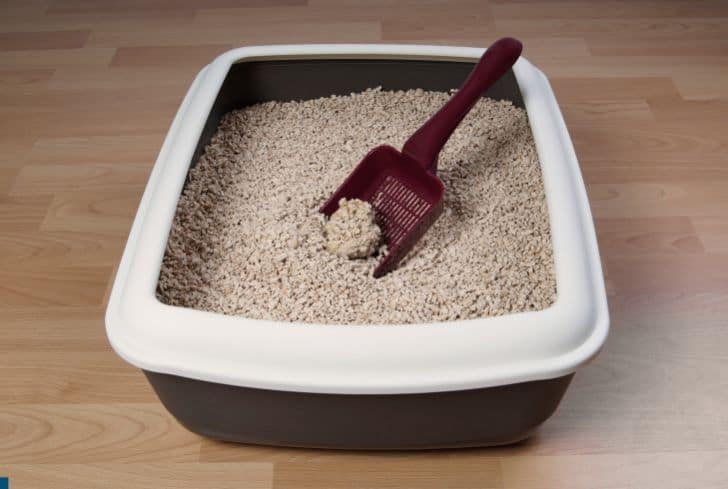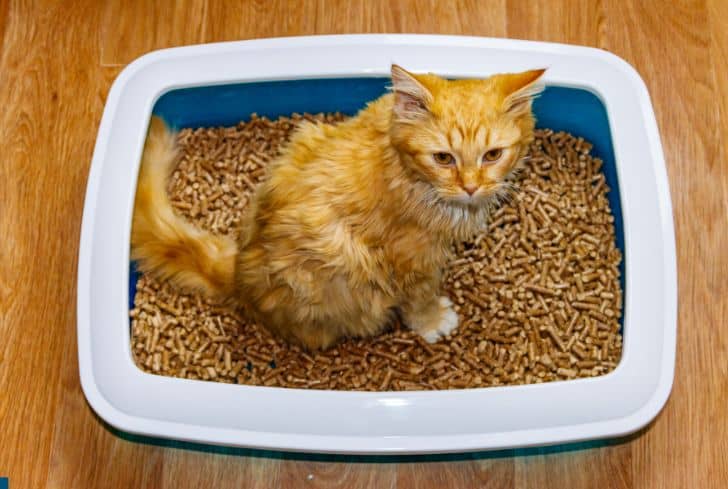42.7 million households in the US own a cat. Feline creatures may be renowned for being prickly and proud, but there is no doubt that we love their presence.
On the other hand, we cannot say the same about their waste, so we rely heavily on cat litter. Every cat owner has found a little surprise in their shoe, bag, or even under the blanket! So, we are grateful for cat litter.
However, we must also ask if cat litter is bad for the environment if we intend to live sustainably. One surefire way to heal the ecosystem is to live with less impact, which is why we are considering different cat litter types and post-use effects. Enjoy!
What is Cat Litter Made Of?
It depends, but bentonite clay is the most popular option for US residents. Other options include silica gel, grass, and natural substances like wheat, corn, and pine. Cat litter exists in various forms, with different base materials that are either natural, synthetic, or a combination of both.
The cat litter market is worth $10.89 billion and is expected to grow even larger by 2025. If you have a feline housemate, you will agree that clumping cat litter is a godsend because it absorbs odors and moisture, making it easy to dispose of the waste.
You only need to scoop and pack up, then refill. The time difference between each cleanup depends on the type of cat litter you use. Still, silica gel is renowned for absorbing a massive quantity of moisture, ensuring longevity. Of course, this explains the steeper price compared to your other options.
Silica gel is a desiccant, and it is made of silicon dioxide or silica. Silica is a component of sand that can absorb moisture, making it an excellent fit for a household with a feline friend or two.
Clay clumping litter is made of bentonite clay, a type of sand that also absorbs moisture.
Investing in pine-based cat litter is also an option, and of course, this one is made with pine. There are other natural options like corn, wheat, and grass; they also have excellent moisture retention abilities and clump appropriately.
How Does Cat Litter Impact the Environment?
If cat litter is made from bentonite clay, the most popular consumer option, it does have the greatest environmental impact because of the mining process. Mining is one of our more disastrous industrial activities, affecting the land, atmosphere, and water bodies.
Let’s explore the effects of cat litter from the manufacturing process on how we dispose of them.
To start with, cat litter is available in varieties: corn-based, wheat-based, pine-based, silica crystal, clumping, and non-clumping, to name a few.
Now, those made from renewable natural resources don’t negatively impact the environment when you harvest and make more cat litter with these materials. You can plant them limitlessly which means we never run out of supply.
Examples include wheat-based cat litter, corn-based cat litter, and pine-based cat litter.
On the other hand, the synthetic option, which is silica crystal-based cat litter, is more technical to manufacture. It is made of sand which manufacturers must melt at extreme temperatures to make it liquid and pliable. Therefore, it is safe to say that silica crystal cat litter is not also the best for the environment.
Clumping clay is often made from sodium bentonite clay, and the extraction process causes disruptions to the ecosystem.
Let’s also consider the disposal methods. Cat fecal matter often contains a toxic substance called toxoplasma gondii which can transfer to plants and the soil and harm biodiversity. This is why it is best to dispose of your pet’s feces properly.
So, it is safe to say that composting is not an option. Unless you are using natural-based cat litter, it is unlikely that the waste will even decompose properly.
Sure, it will eventually degrade, though it may take a long time. However, the process is unenviable for the environment, considering cat fecal matter contains harmful pathogens.
In a nutshell, cat litter is not the best for the environment, especially the nonbiodegradable options. This is in terms of manufacture and disposal.
Is Clay Cat Litter Bad for the Environment?
Is clay cat litter bad for the environment? The answer to this is a resounding yes! Clay litter is bad for the ecosystem first because of the method of obtaining this resource. It is called strip mining, which takes away the top portion of the land, rendering the area useless for biodiversity, like animals and plants.
This type of cat litter is the most popular option due to its affordability. However, it has one of the least desirable clumping properties, which means you will likely use a significant amount yearly. You know how cats get when they meet an unclean litter box.
Clay-based litter is bad for the environment also because it does not biodegrade. It does not supply any nutrients to the soil, so there is no reason to turn it into humus. Therefore, it will simply sit in the landfill for long years, breaking down slowly into smaller particles. Hundreds of years can pass, and nothing will change.
In other words, clay-based cat litter is akin to transferring clay from one place to another. Still, the final destination is a landfill, which is a substance capable of poisoning biodiversity in the area.
Another reason clay-based litter is bad for the environment is because of the manufacturing process. Massive energy is required to extract the amount of clay-based cat litter that US residents use yearly. Think about it.
Is Silica Cat Litter Bad for the Environment?
Yes, silica cat litter is bad for the environment. Starting with the manufacturing process to the energy consumption and then the disposal requirements. Suffice it to say that there are many other sustainable options for your feline housemate. Furthermore, toxic chemicals are sometimes added to cat litter which is harmful to you, your cat, and the environment after disposal.
You would enjoy using silica cat litter because of the ease it offers you and your cat. This material is highly absorbent; each ball can absorb forty times its weight in water!
However, this water retention ability is derived from mixing water, sand, and oxygen. Sand is a non-renewable resource, no matter how inexhaustible it seems. We can run out of sand even though it may not happen yet.
Renewable resources, like cat litter, are better for consumption on a large scale. Many homes in the US have cats, which means they certainly burn through a significant portion of sand. Therefore, silica cat litter is bad for the environment because it is not sustainable.
As a non-natural resource, the possibility of exhausting our supply should spur us to search for sustainable options.
Turning sand into silica cat litter requires significant consumption of energy. The ozone layer will be affected if this is a constant industrial activity.
Furthermore, silica cat litter is nonbiodegradable, which means it will not be broken down by the activities of microorganisms in the soil. Silica cat litter is still sand, and yeast and fungi cannot break down this material.
However, the saving grace is that you don’t need as much silica gel because of its great absorbing capacities. Therefore, less will be thrown out, which is better for the ecosystem and sustainability trends.

Is Crystal Cat Litter Bad for the Environment?
Is crystal cat litter bad for the environment? Well, we will say a resounding yes, and the reason is because of the extraction process. Crystal cat litter is not extracted as crystals but is first in the form of quartz sand. Then, a series of manufacturing processes help turn it into suitable cat litter.
Crystal cat litter is a godsend to houses with cats. It comes in attractive blue and white crystals that don’t get stuck in your cat’s claws or expose him to dust or particles.
You can also flush some brands down the toilet, which is a good alternative when you are in a bind. The best part is that the crystals change from blue to yellow, indicating that they need to be replaced.
However, the problem with crystal cat litter is what it is made from. Silica dioxide sand is limited, even though oxygen and water, the other two components, are in abundant supply.
Regardless, it is safe to say that crystal cat litter is not a sustainable choice in terms of manufacturing. Disposal, too, isn’t the best for the environment because of the nonbiodegradable nature of this material. It will simply sit in landfills indefinitely.
Is Silica Gel Cat Litter Bad for the Environment?
Silica gel cat litter is bad for the environment because of how it is manufactured and disposed of. It is made from quartz sand, which is a non-renewable resource. Given the rate of cat litter consumed globally, it simply isn’t reasonable to continue production with this specific material because we can use up our supply.
Another reason silica gel cat litter is bad for the environment is the amount of energy consumed in manufacturing it. This is a large amount of fossil fuel, which, when burnt, won’t do the atmosphere any good.
Unfortunately, a production like that cannot occur without using chemicals. These chemical wastes are often disposed of incorrectly, polluting the environment and endangering biodiversity.
And finally, when you dispose of silica gel cat litter, it sits in the landfill for a very long time, only dissipating after centuries have passed.
What Kind of Cat Litter is Biodegradable?
Your options include corn litter, grass seed cat litter, pine-based cat litter, and wheat-based cat litter. These products are also capable of absorbing and clumping, although they may not be as effective as artificial clumping cat litter.
If you want to go green, your cat litter is an excellent start. Some brands produce natural options, which we will discuss shortly.
Three Best Eco-Friendly Cat Litters
Here are the three best eco-friendly cat litters according to popular consumer choices:
1. Naturally Fresh Walnut-Based Cat Litter
Made entirely from walnut shells, this eco-friendly cat litter clumps fast. It also absorbs the smell of ammonia super-efficiently. It is unscented and lacks the typical cat litter dust.
2. FelinePine Non-Clumping Litter
This cat litter is made with pine needles, as the name implies. It is natural, clumps fast, and doesn’t smell. It also provides a comfortable environment for your kitty to do his business.
3. Okocat
Okocat cat litter is made from natural wood fiber. It is a clumping product that also controls odors.
How do you Dispose of Clay Cat Litter?
The most environmentally friendly method of disposing of cat litter is carefully bagging it and throwing it into the garbage can. Ensure the can has a cover to prevent neighborhood pets and rodents from uncovering it. You must exercise caution when disposing of cat litter because of toxoplasma gondii, a parasite that lives in a cat’s poop.
Conclusion
Your cat litter is also a significant contributor to the environment’s mess. How can you make a change? Start by actively choosing ecofriendly cat litter.






